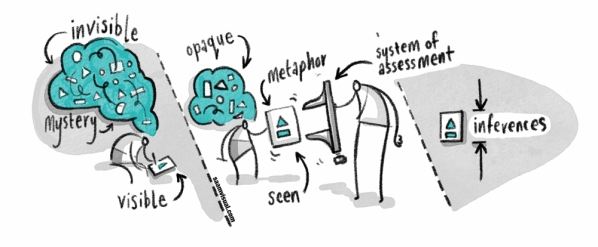Image: @jasonramasami
I have read David Didau’s two recent posts on assessment – here and here – with interest. David is rightly sceptical about the efficacy of assessment rubrics and has summarised the problem succinctly: “We need always to remember that any system of assessment is an attempt to map a mystery with a metaphor.” In other words, as student learning is invisible and opaque and written work is only a proxy for learning, we must be careful about the inferences we draw so that we avoid over-simplified judgements.
This has got me reflecting on how I have assessed students in my English lessons over the last few years. What follows is not advice, just a description of the developments I have been through. About three years into teaching, I stopped using descriptors almost entirely, especially with my key stage 3 classes. I would pay lip service to APP and the like, but in reality I would read the child’s work and award a grade based on gut instinct. Although I kept my little secret to myself, this never became an issue: in standardisation meetings my marking was no more or no less accurate than anybody else’s. It is easy to put work in rank order and assign a grade; it is much harder to explain why. These days, when I want to communicate or learn what quality work looks like, I always seek out examples and models to share or adapt for teaching.
My theory is that the mental models we develop as teachers – of a) what progress and standards look like in our subjects, and b) where individual students are in relation to these – are of far more importance than lists of crude, meaningless assessment sentences. Consider for a moment the sheer complexity involved in assessing a page of student writing. Any fair and accurate assessment must consider a broad range of aspects, including grammar knowledge/application, topic knowledge, understanding of textual conventions, writing habits, level of effort exerted, working conditions (were they rushing to finish or carefully redrafting?), originality (did they only parrot what they had heard in class or did they make it their own?), etc. In other words, work is the product of many factors, only some of which are visible to the teacher.
Secondly, the accuracy of assessment should play second fiddle to what we should be attending to, which, to borrow John Hattie’s metaphor, is helping students to become ‘unstuck’ – i.e. the way that we we respond to work so a student learns more and learns better as a result. Many social and cognitive factors play a part in this and, surely, these decisions are where teacher expertise really lies.
Below is a paragraph written last week by one of my Y8 students. The class were writing from Lady Macbeth’s perspective:
My assessment of this paragraph is far stronger when I leave rubrics and descriptors to one side. Immediately, I can see a few areas she needs to work on, such as:
1. The paragraphing of direct speech.
2. The unfortunate splice comma habit she has adopted (more noticeable in earlier paragraphs).
3. The unsophisticated syntax – e.g. ‘we both were in our night clothes’.
4. The ambition of vocabulary choice.
5. The depth of insight into Lady Macbeth’s thoughts/feelings.
However, I also know this paragraph was rather rushed; she was writing very quickly in timed conditions and this was the last paragraph. It would be unwise, therefore, to draw too many conclusions about her knowledge and skill levels from this paragraph alone. It would also be easy, for instance, to read this piece and infer that she cannot spell ‘successful’ … but perhaps it was just a one-off slip-up? (She added in the extra ‘s’ after I had circled the mistake.) If I tried to map her against an assessment grid, it would only lead to abstract and unhelpful targets based on the faulty assumption that all children become successful writers by following the same path.
Ultimately, lists and grids of nebulous assessment criteria are a smokescreen, unnecessary distractions that infantilize and over-simplify the assessment process. If I could have my way, I would ditch almost all summative assessment and throw everything into improving my expertise in delivering formative assessment. So that we could pool this expertise, subject departments would regularly meet to share and discuss the work of those tough students’ for whom progress and learning seem intractable.
Like student learning, teacher assessment skill is largely invisible. We need to find more opportunities to make this genuinely tangible.
Related post:
726 ways to achieve good exam results (or why the solution should be smaller than the problem)



